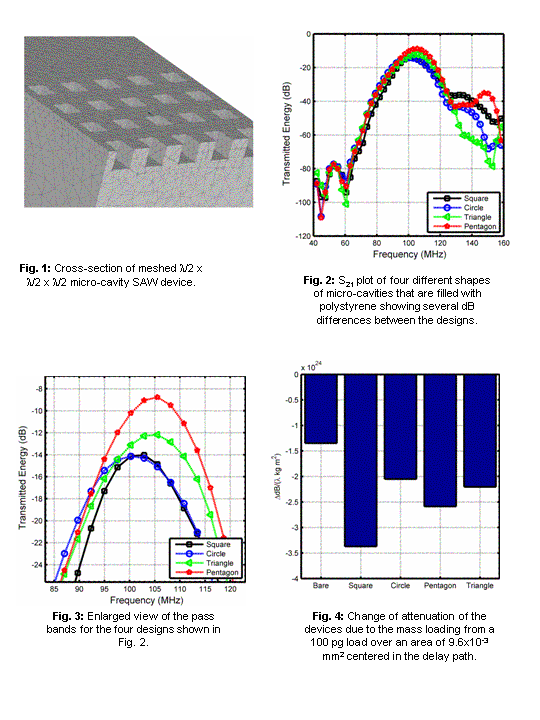683c Shape Dependence of Polystyrene Filled Micro-Cavities In LiTaO3 Shear Horizontal Surface Acoustic Wave Sensors
In this work, we present a finite element analysis study of square, circle, triangle and pentagon shaped micro-cavities filled with polystyrene to vary the sensitivity and operational frequency of shear horizontal surface acoustic wave sensors. The micro-cavities are based on λ/2 side length/diameter and λ/8 depth etched into a 36° YX LiTaO3 substrate. By altering the shape of the micro-cavities, the angle at which the surface wave hits the edges of these cavities is altered for the primary shear horizontal wave as well as for the leaky waves (bulk waves) and subsequent reflected waves. The polystyrene filling of the micro-cavities, similar to that in a Love-wave device, acts to entrap energy; these inhomogeneous waveguide structures for surface acoustic wave sensors have not been previously reported in the literature. Surface acoustic wave devices have been used as sensors for many years; however, the devices used are typically non-optimized designs or have been optimized for a different use such as band-pass filters . Although these devices work as sensors, there are many modifications that can be made to improve the device for sensor applications. Our previous theoretical and experimental research has shown considerable improvements to sensor characteristics through the use of advanced interdigital transducer design . We have hypothesized that it is possible to modify the delay path of a surface acoustic wave sensor to further improve sensor characteristics, such as power consumption and sensitivity. Four designs of polystyrene filled micro-cavities (the square pattern is shown as a meshed sectioned structure in Fig.1) were measured for characteristics common to surface acoustic wave devices and sensors. Shown in Fig.2 are the transmitted energy plots for the square, circle, triangle and pentagon designs. From these data, we see the general band-pass characteristics of the devices are similar, with the pentagon device exhibiting several decibels greater energy transmission. Further details of the passbands are shown in Fig. 3 where a 5 dB increase in energy transmission is clearly shown for the pentagon over the circle and square designs. Based on our simulation data, we find that Love waves incident on a shallow groove or cavity on the surface of a piezoelectric substrate filled with another elastically isotropic material such as polystyrene is weakly scattered with a part of the energy contained in the reflected and the transmitted Love waves and the other part converted into the bulk shear waves that propagate into the substrate. Our analysis of displacement vector plots for the each of the four designs indicated that these improvements (pentagon>triangle>square>circle) were brought about by a larger coherent reflection of the incident Love wave and subsequent reduced conversions into bulk shear modes which radiate into the substrate. Our simulation results also suggest that although more energy is lost by the square design than the pentagon design, the square design is more sensitive to mass additions to the surface of the delay path as shown in Fig. 4. This figure also contains data from a plain (bare) surface acoustic wave sensor as reference. The present study indicates that micro-cavity based sensor designs are a significant improvement over the typical sensor designs based on conventional surface acoustic wave propagation. 1. D. S. Ballantine, R. M. White, S. J. Martin, A. J. Ricco, E. T. Zellers, G. C. Frye, and H. Wohltjen, Acoustic Wave Sensors: Theory, Design, and Physico-chemical Applications. San Diego: Academic Press, 1997. 2. S. Cular, S. K. R. S. Sankaranarayanan, V. R. Bhethanabotla, and D. W. Branch, "Interdigitated Transducer Design for Biosensor Applications Requiring Love-wave Surface Acoustic Waves," IEEE Transactions on Ultrasonics, Ferroelectrics, and Frequency Control -- Submitted, 2008. 3. S. Cular, "Designs and Applications of Surface Acoustic Wave Sensors for Biological and Chemical Sensing and Sample Handling," in Department of Chemical & Biomedical Engineerings. Doctor of Philosophy. Tampa: University of South Florida, 2008, pp. 252.
